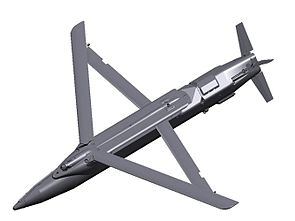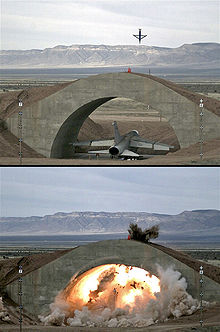Small diameter bomb
| Small diameter bomb | |
|---|---|
| General Information | |
| Designation: | GBU-39 Small Diameter Bomb |
| Type: | Glide bomb |
| Country of origin: | United States |
| Manufacturer: | BDS |
| Development: | 2001 |
| Commissioning: | 2006 |
| Working time: | til today |
| Unit price: | 40,000 USD |
| Technical specifications | |
| Combat weight: | 129 kg (SDS) 145 kg (carrier) 662 kg (carrier with four SDSs) |
| Length: | 1.80 m (SDB GBU-39) 3.21 m (carrier BRU-61) 3.63 m (carrier with four SDBs) |
| Diameter: | 190 mm |
| Span: | 1380 mm |
| Range: | 110 km |
| Furnishing | |
| Warhead: | 93 kg, of which 23 kg are conventional explosives |
| Steering: | GPS , INS |
| Weapon platforms: | F-15E Strike Eagle |
| List of bombs by country of origin | |
The Small Diameter Bomb (short: SDB ; German: "Bomb with a small diameter") is a precision-guided bomb used by the US armed forces . The NATO code is GBU-39 Small Diameter Bomb . After the GBU-44 Viper Strike , the SDB is the smallest precision-guided bomb used by the US armed forces and has been in use since September 2006.
Development history
competition
Development of such a bomb began in the mid-1990s. The US military was looking for a bomb of the 250 pound class (around 113 kilograms) with high accuracy in order to be able to increase the number of bombs per aircraft and thus the number of hits per mission. The smallest precision bomb used by the US armed forces to date was the GBU-38 Joint Direct Attack ammunition , which was introduced in 1998 and was twice as heavy . The stealth aircraft B-2 and F-22 used by the US Air Force and the F-35 , which is currently in development, should benefit from the new weapon, as they could carry more than twice the number of bombs in the weapon bay without their radar cross-section to increase. The smaller warhead could also reduce the accompanying damage .
The US Air Force divided the development of the bomb into two phases:
- SDB I should be able to fight stationary targets and find its target using the global positioning system and inertial navigation . Triggering from as great a distance as possible should minimize the danger to the aircraft and the pilot.
- The SDB II should also be able to hit moving targets and be equipped with an IR seeker head for automatic target acquisition and an extended communication interface.
By 2001, the lead Air Armament Center at Eglin Air Force Base investigated 26 concepts of a “smart” small bomb and in September 2001 commissioned Boeing and Lockheed Martin to develop the Small Diameter Bomb . At the same time, the armed forces assigned the model names for the new bomb versions: GBU-39 and GBU-40 for Boeing's SDB I and SDB II and GBU-41 and GBU-42 for Lockheed Martins SDB I and II. In October 2003, Boeing became finally declared the winner of the competition and commissioned with the further development of its version.
SDS I
The weapon carrier (BRU-61A) specially developed for the SDB system contains electronics for controlling the bombs and pneumatic bomb triggers. It can hold four SDBs and can be attached to external load stations as well as to rotary starters in bomb bays. In principle, the SDB is therefore compatible with all combat aircraft and bombers of the US armed forces. After the release, the wings and four tail fins unfold, which provide a range of up to 100 kilometers when released from a great height and at high speed. Despite its small size, the Small Diameter Bomb has the same penetration power as a 2,000 pound (907 kg) conventional bomb, about three feet in reinforced concrete.
The US Air Force's F-15E served as the test platform for the GBU-39 . The first flight took place on February 25th, the first controlled flight on May 23rd, 2003. By the end of 2005, 37 test flights had taken place, 35 of which were classified as successful. Boeing received its first production contract on April 22, 2005, and on May 22, 2006 the company delivered the first serial production SDB-I system to the Air Force. The 48th Fighter Wing with its F-15E in RAF Lakenheath (Great Britain) has been the first unit ready for action with the GBU-39 since September 2006 and was relocated with the new weapons to the Southwest Asian war zone in the same month. On October 2, 2006, the Air Combat Command officially declared the Small Diameter Bomb to be operational. The F-15 took them for the first time on October 5 in a combat mission and used them on October 11, 2006 for the first time in close air support in Iraq.
Since August 2006, Boeing developed a SDB variant in which the steel shell of the warhead by a housing made of carbon fiber - composite material is replaced. As a result, the version designated as Focused Lethality Munition (FLM) (German: ammunition with concentrated lethality) is supposed to have a more targeted penetration power, with at the same time less accompanying damage than the standard SDB. For a total of 27 million US dollars, 50 SDB-I-FLMs are to be delivered to the Air Force for test purposes by mid-2008. Boeing delivered them by the end of February 2008.
On September 5, 2007, an F-22 Raptor first dropped a Small Diameter Bomb from its internal weapon bay.
It is planned to procure 24,000 Small Diameter Bombs I (GBU-39) and 2,000 weapon carriers (BRU-61) by 2015 for a total of at least 1.63 billion US dollars . The first two construction lots comprised around 760 bombs and 175 carriers. On December 8, 2006, Boeing received an order for the third lot of 1561 SDB I, 300 BRU-61 and accessories for $ 80.1 million. With this third construction lot, which is to cover production until September 2008, the full scale production of the SDB begins.
By the end of February 2008, 1,000 SDB I and 200 BRU-61 weapon carriers had already been delivered, which means that Boeing is ahead of the original schedule.
Israel used GBU-39 / A bombs in early January 2009 during Operation Cast Lead in the Gaza Strip to destroy Hamas tunnels and underground Qassam launchers .
SDS II
Originally, both development phases of the Small Diameter Bomb were to be covered by a single order. However, since the US Air Force illegally preferred Boeing when awarding the contract in autumn 2003, the competitor Lockheed Martin successfully protested in November 2004 after the circumstances became known. The Luftwaffe therefore rewritten the development and production of the SDB II. Since April 2006, Boeing has been competing in this competition with Lockheed Martin as a partner against rival Raytheon . The Boeing / Lockheed Martin prototype was first dropped on May 22, 2007. The test took place with an F-15E at Eglin Air Force Base . The decision in favor of a provider is planned for 2009, the commissioning for 2014.
The US Navy is also interested in this version for combating moving targets .
GLSDB
Together with SAAB, Boeing developed a ground-based version with a rocket motor, the GLSDB (Ground-Launched Small Diameter Bomb). The weapon was designed so that it can be shot down from the MLRS platform . Each MLRS can carry two launch containers, each equipped with six missiles. The first launch tests took place in 2015. The range of the GLSDB is 150 kilometers.
Web links
- Small Diameter Bomb at globalsecurity.org (English)
- SDB at Boeing (English)
- Airpower Australia Technical Report (English)
Individual evidence
- ^ Russell Wicke: ACC declares small diameter bomb initially operational. Air Force Print News, Oct. 5, 2006
- ↑ Boeing-PDF for SDB-FLM from September 2007 (38 kB)
- ↑ Jason Hernandez: Raptor performs first drop of small diameter bomb. ( Memento from Oct. 24, 2007 on Internet Archive ) 95th Air Base Wing Public Affairs, Sept. 26, 2007
- ↑ Boeing and Lockheed Martin Complete Successful SDB II First Flight. ( Memento of October 11, 2007 in the Internet Archive ) Boeing News, June 6, 2007
- ↑ http://www.defensenews.com/story/defense/land/weapons/2015/03/10/boeing-saab-small-diameter-bomber-ground-launch/24705183/
- ↑ http://www.army-technology.com/projects/small-diameter-bomb-glsdb/


